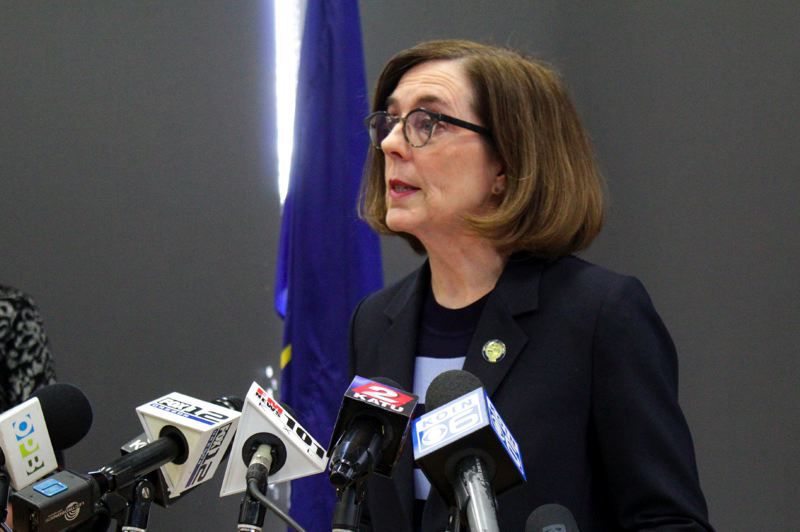Brown state budget proposal relies on help from Congress
Published 2:00 pm Tuesday, December 1, 2020

- Gov. Kate Brown
Gov. Kate Brown began the seven-month duel with the Legislature over the next state budget on Tuesday, unveiling a $25.6 billion plan to shift priorities to reflect problems since the COVID-19 pandemic hit the state last March.
“The events of this year will forever change the meaning of 2020 vision,” Brown said.
Trending
The still surging virus, restrictions on businesses and activity, demonstrations over civil rights, and wildfires that burned over one million acres forced the change, Brown said.
“The pandemic has led to a state budget shortfall that will require not only scrapping plans for long-needed investments, but also making small but difficult cuts in services and programs that affect Oregonians’ lives daily,” she said.
The Legislature will get Brown’s budget proposal January. The course of the pandemic should be clearer by the time the Legislature passes the final budget at the end of June, when Brown’s vision of a partnership with Washington in Oregon’s recovery will have had its reality test.
The new budget would close three state prisons, while most state programs and institutions would see spending capped at current levels. Hospitals would be asked to help pay for part of the $718 million budget shortfall of the Oregon Health Plan. The safety-net medical program added 150,000 people amid the economic tumult of the pandemic.
Democrats hold supermajorities in the state Senate and House, allowing them to pass budget bills without Republican votes. But lawmakers have competing agendas from Brown — and among themselves, as seen by the recent attempt to replace House Speaker Tina Kotek, D-Portland.
More significantly, Brown’s budget is predicated on help from Congress and the White House.
Trending
“It’s time for Washington to get its act together,” Brown said.
Oregon received an estimated $1.37 billion in federal aid linked to the pandemic and most of it is gone or will cease on Dec. 30. The state’s latest economic and revenue forecast, released last month, showed state revenues were stronger than expected due to income tax payments and lottery receipts, among other areas. The forecast said the state would see a rebound in some sectors by summer and the economy would be in recovery by 2023, though jobs and wages would lag.
But the relatively sunny scenario was based on two items that Brown is also counting on in her budget: A COVID-19 vaccine and a major infusion of federal aid. The state could receive its first small shipment of Pfizer vaccine on Dec. 15, though inoculation of the entire state would stretch on most likely to summer.
President Donald Trump and Congress have not acted to renew state aid programs. President-elect Joe Biden has promised to revive help to governors after he takes office on Jan. 20. Even then, funds hinge on Congress, where Democrats control the House but a pair of special elections in Georgia next month will determine which party will lead the Senate. If Republicans hold on to the chamber, they could slow or stop money going to the states.
In the meantime, Brown said she likely to announce a “catastrophic disaster” because of the virus, which has killed 936 people in the state. The move would possibly allow for a virtual session of the Legislature this month to enact stop-gap bills to bridge the end of the federal spending and its hoped-for resumption in January.
Helping businesses keep workers on payroll: Brown wants to renew the Paycheck Protection Program for small businesses that offered loans in exchange for promises to use the money to pay employees to stay on the job during times when businesses are closing or cutting back. The loans can become grants that do not require reimbursement to the federal government if conditions are met.
Unemployment: Brown wants Congress to revive the monthly $600 monthly federal add-on to state unemployment benefits. Her budget asks for $146.4 million for the long-delayed fix of Oregon’s antiquated unemployment benefits computer system that led to months-long backups in payments that continue to today. Brown underscored that all programs will assist people “regardless of immigration status.”
Housing and homelessness: Brown wants $350 million in rental assistance to help Oregonians stay in their homes. Her budget gives a $65.9 million increase for housing and homeless programs, $20 million in homeowner assistance, and $250 million to develop more affordable housing.
Child care support: Brown wants to assist Oregonians to go back to work by helping defray costs of care for children while parents work. A federal survey found that one million mothers nationwide had to quit their jobs during the pandemic to care for children who would otherwise be in school or daycare.
Wildfires: The state budget features several separate efforts to deal with wildfire recovery, including reconstruction and repair, debris cleanup, tree removal, shelter and housing, and food assistance. The budget earmarks $189.5 million to rebuild communities destroyed or damaged by the fires. Another $170 million in community development funds will be allocated through The governor’s Wildfire Economic Recovery Council. Improving future fire response and resources would receive $73.7 million. Spending includes $30 million for the Department of Forestry, and $40 million for programs suggested by the Governor’s Council on Wildfire Response. Another $47 million goes to grants and loans for other wildfire recovery efforts.
The state will also shift focus on many programs and spending priorities for issues that have come into sharper focus during the pandemic, wildfires, protests over police response in the community, and other impacts on the economy and well-being of Oregon residents:
Long-term care: Brown asks for investments in improvements, training and new “strategies” to support and protect seniors living in assisted living and nursing homes. Oregon is one of 13 states where more than half of the total COVID-19 deaths came from long-term care facilities, according to a New York Times analysis.
Education: Brown would spend $9.1 billion on the State School Fund and draw $215 million from the Education Stability Fund to back-fill school budgets. A $118 million rural broadband program was boosted by problems students outside of major population areas had with distance learning. Slots for 8,000 children in early learning programs will be financed. Public universities and community colleges will see spending remain about the same as current budgets. Oregon State University-Cascades would received state bonds for continued construction on the Bend campus.
Criminal justice reform: The budget would close three of the state’s 16 prisons: Warner Creek Correctional Institution in Lakeview, Shutter Creek Correctional Institution in North Bend, and Mill Creek Correctional Facility in Salem. The prisons were no longer needed for the state’s inmate population, Brown said. She also announced programs to look into the over-representation of Blacks in the inmate population, expanded police accountability, support drug courts to divert lower-level offenders, and fix funding and facility issues in the Department of Corrections.
Environmental reform: The governor would include the impact of climate change, wildfires, water quality and access, on underrepresented communities by creating an Office of Environmental Justice. Brown considers greenhouse gas reduction and water access reform as both environmental and social equity issues.




